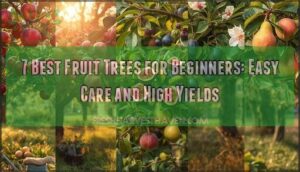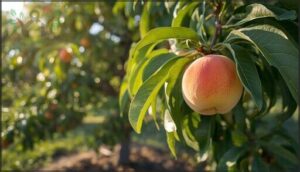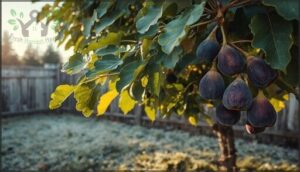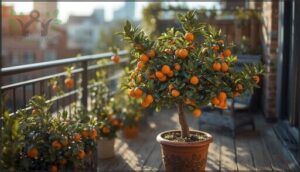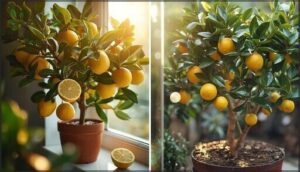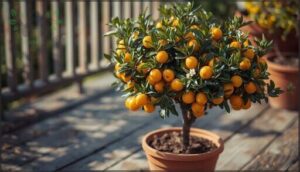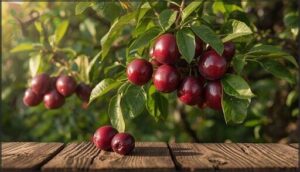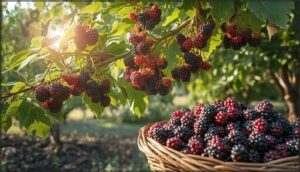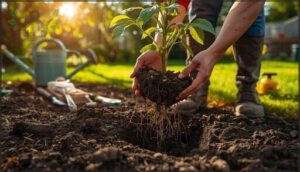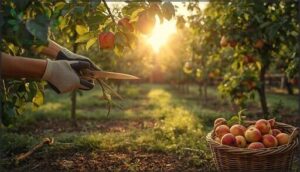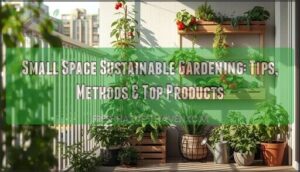This site is supported by our readers. We may earn a commission, at no cost to you, if you purchase through links.
Most beginner fruit growers abandon their trees within the first two years—not because growing fruit is inherently difficult, but because they chose varieties that demanded expert-level attention from day one. You don’t need a horticulture degree to harvest bushels of homegrown apples or plums. You need trees that forgive watering mistakes, shrug off common pests, and produce fruit without requiring a pollination partner or precise pruning schedules.
The best fruit trees for beginners share specific traits: self-fertile varieties that don’t need a second tree nearby, natural disease resistance that reduces spray schedules, and climate adaptability that tolerates your zone’s temperature swings. These seven varieties deliver reliable harvests while you’re still learning the fundamentals of fruit tree care.
Table Of Contents
- Key Takeaways
- Key Factors for Beginner Fruit Tree Success
- Easiest Fruit Trees to Grow for Beginners
- Peach ‘Elberta’ — Pest and Disease Resistance
- Fig ‘Chicago Hardy’ — Cold Hardy and Self-Fertile
- Mandarin ‘California Honey’ — Compact and Productive
- Lemon ‘Improved Meyer’ — Indoor and Outdoor Versatility
- Kumquat ‘Fukushu’ — Container-Friendly and Low Maintenance
- Plum ‘Toka’ — Self-Fertile and Sweet Fruit
- Mulberry ‘Illinois Everbearing’ — High Yield and Adaptable
- Choosing The Right Fruit Tree for Your Garden
- Planting and Caring for Beginner Fruit Trees
- Essential Tips for Stress-Free Fruit Tree Maintenance
- Frequently Asked Questions (FAQs)
- Which is the easiest fruit tree to grow?
- What is the easiest fruit to grow yourself?
- Which fruit tree is good for the backyard?
- Which fruit tree is best to grow?
- What fruit trees can you grow in your backyard?
- Are fruit trees easy to grow?
- Are fruit trees difficult to grow?
- What are the easiest backyard fruit trees to maintain?
- Which fruit trees grow fastest?
- Which fruit tree is best for the backyard?
- Conclusion
Key Takeaways
- Beginner success hinges on choosing self-fertile varieties with natural disease resistance and climate adaptability that forgive mistakes while you’re learning the fundamentals of fruit tree care.
- Understanding your USDA hardiness zone and chill hour requirements before buying prevents years of frustration, since a tree that survives winter isn’t the same as one that’ll actually produce fruit.
- The easiest beginner trees—like ‘Chicago Hardy’ fig, ‘Improved Meyer’ lemon, and ‘Illinois Everbearing’ mulberry—thrive with minimal pruning, resist common pests, and don’t need a second tree for pollination.
- Smart planting means matching tree size to your available space, testing soil pH before you dig, and committing to consistent watering through that critical first growing season.
Key Factors for Beginner Fruit Tree Success
Growing fruit trees doesn’t have to be complicated, but success starts with understanding what your trees actually need. Getting a few fundamentals right from the start will save you frustration down the road and set you up for healthy harvests.
Let’s break down the key factors that’ll make or break your beginner fruit-growing experience.
Understanding Chill Hours and Hardiness Zones
Before you plant, you’ll want to nail down two numbers: your USDA hardiness zone and your site’s chill hours. Hardiness zone mapping tells you the coldest temperature your tree can survive, while chill hour calculation—time between 32–45°F—determines whether your tree will actually break dormancy and fruit. Think of hardiness as survival and winter chill models as productivity.
Climate zone assessment matters because a tree that won’t die isn’t the same as one that’ll thrive. Understanding the concept of chill hour requirements is essential for selecting the right fruit trees for your area.
Importance of Sunlight and Soil Quality
Your tree needs at least six hours of direct sunlight daily—eight is better—because photosynthesis drives fruit yield. Soil quality matters just as much: most fruit trees want pH between 5.8 and 7.0, strong soil structure for drainage, and aeration around roots. Poor soil conditions stunt growth and invite disease.
For gardening for beginners, test your growing conditions before you buy, and tree care starts with getting the fundamentals right. Understanding the importance of full sun requirements is vital for peak fruit tree health.
Pollination Needs: Self-Fertile Vs. Cross-Pollinating
Pollination methods directly affect fruit set, so you need to understand the difference. Self-fertile trees like peaches and figs produce fruit using their own pollen, perfect for beginners planting a single tree.
Cross-pollinating varieties—many apples, pears, and sweet cherries—require a compatible partner nearby for pollen transfer. Without it, you’ll see sparse yields despite healthy growth.
That’s why checking self-fertility before you buy saves frustration later.
Cold Tolerance and Climate Adaptability
Beyond pollination, your tree’s winter resilience determines whether it thrives or struggles year after year. Cold hardiness ratings tell you if a variety survives your zone’s lows, but chill hours—those 32–45°F stretches—dictate whether it flowers and fruits properly.
Climate shift is nudging growing zones northward, expanding options for some species while reducing chill accumulation for high-requirement apples and pears. Climate considerations and frost protection during bloom become part of smart fruit tree selection.
Easiest Fruit Trees to Grow for Beginners
You don’t need to be an expert to grow your own fruit—some trees practically take care of themselves. The varieties below thrive with minimal fuss, resist common problems, and reward you with delicious harvests year after year.
Some fruit trees thrive with minimal effort, resisting common problems while delivering delicious harvests year after year
Here are seven beginner-friendly fruit trees that make growing your own food feel achievable from day one.
Peach ‘Elberta’ — Pest and Disease Resistance
You’ll love that ‘Elberta’ peach offers solid disease resistance compared to many older cultivars, though don’t expect it to be entirely hands-off. Fungal resistance is decent when you provide good air circulation through proper spacing and pruning.
For bacterial control and root health, well-drained soil is your best defense.
With basic pest management—monitoring for borers and occasional spraying—this peach tree rewards beginners with consistent harvests.
Fig ‘Chicago Hardy’ — Cold Hardy and Self-Fertile
If you’re in a cold climate where most figs won’t survive, ‘Chicago Hardy’ changes the game. This self-fertile fig tree bounces back from roots even in Zone 6, making fruit production possible without the cross-pollination hassles beginners dread.
It’s perfect for urban gardening in tight spaces, needs minimal pruning, and shrugs off most diseases—exactly what novice gardeners need for stress-free fig tree care.
Mandarin ‘California Honey’ — Compact and Productive
‘California Honey’ mandarin solves the space problem many beginners face—this dwarf citrus tops out around 8–10 feet and thrives in containers as small as 15 gallons.
You’ll get self-fertile fruit tree care without needing a pollinator, and compact gardening becomes reality when one mature plant delivers dozens of sweet mandarins yearly.
It’s perfect for growing fruit trees on patios or balconies where ground space doesn’t exist.
Lemon ‘Improved Meyer’ — Indoor and Outdoor Versatility
‘Improved Meyer’ lemon delivers both indoor and outdoor flexibility. Zones 8–11 support ground planting, while colder climates can keep container gardening thriving year-round on bright windowsills.
You’ll master self-fertile fruit production without a pollinator, and tree pruning keeps plants manageable at 8–12 feet outdoors or compact indoors.
Beginners appreciate consistent lemon care that yields dozens of sweet-tangy fruits annually with proper light and nutrition.
Kumquat ‘Fukushu’ — Container-Friendly and Low Maintenance
‘Fukushu’ kumquat thrives in containers, making it perfect for patios and balconies where in-ground space doesn’t exist. This compact choice ranks among the easiest to grow fruit trees for beginners:
- Self-pollinating flowers eliminate the need for multiple dwarf trees
- Container care requires only 15–20 gallon pots for sustained fruit yield
- Low maintenance nature tolerates heat and adjusts to indoor growing
- Beginner gardening tips emphasize minimal pruning for kumquat varieties
Your fruit tree care and maintenance stays simple while growing fruit trees for beginners delivers reliable harvests.
Plum ‘Toka’ — Self-Fertile and Sweet Fruit
‘Toka’ plum stands out among easy-to-grow fruit trees thanks to its self-fertile flowers—no second tree required for sweet fruit production. Growing fruit trees for beginners becomes straightforward when your plum varieties need minimal fruit tree pruning to maintain that attractive vase-shaped canopy.
This self-fertilization trait simplifies fruit tree care and maintenance, while reliable cold tolerance enables tree grafting projects in zones 3–8.
Mulberry ‘Illinois Everbearing’ — High Yield and Adaptable
Where ‘Toka’ plum rewards with sweet simplicity, ‘Illinois Everbearing’ mulberry takes easy-to-grow fruit trees to another level. You’ll harvest waves of berries from spring through fall—minimal tree pruning, no fussy pest control, and it thrives in nearly any soil without elaborate management.
This variety excels in orchard planning for small gardens, delivering delicious harvests with almost zero drama. That’s fruit production made genuinely simple.
Choosing The Right Fruit Tree for Your Garden
Picking the right fruit tree isn’t about grabbing whatever looks good at the nursery—it’s about matching a tree’s needs to what your garden can actually provide. Your climate zone, available space, and even how much attention you’re willing to give all play a role in whether a tree thrives or struggles.
Here’s what to keep in mind before you commit to planting.
Matching Tree Varieties to Your Hardiness Zone
Your USDA zone is the foundation of smart fruit tree selection. The 2023 hardiness mapping divides regions by minimum winter temps, guiding climate considerations like chill hours—apples need 200–1,000 hours, while citrus thrives with near zero.
Cold-hardy cultivars suit zones 3–5, easy to grow fruit trees like peaches fit zones 6–8, and subtropical varieties flourish in zones 9–13, ensuring zone compatibility and success.
Assessing Available Space and Tree Size
After confirming zone compatibility, your garden layout determines rootstock choice. Semi-dwarf trees need roughly 15 feet between trunks—about 225 square feet per tree—while columnar varieties occupy just 2–3 feet, perfect for small gardens or a compact backyard orchard.
Proper tree spacing prevents canopy crowding, fosters healthy root systems, and maximizes fruit yield. Measure your plot, then match easy-to-grow fruit trees to available ground.
Tight quarters? Espalier or container planting opens new possibilities for fruit tree varieties for small gardens without sacrificing harvest quality.
Selecting Trees for Disease and Pest Resistance
Smart plant selection means fewer headaches later. Look for fruit tree varieties bred with resistance to common problems—scab-resistant apples like ‘Enterprise’ or ‘GoldRush’ slash fungicide needs, while bacterial-spot-resistant peaches thrive in humid climates without constant spraying.
Disease-resistant cultivars, paired with good tree care and maintenance, let you focus on harvesting instead of battling outbreaks, giving you real tree immunity through genetics rather than chemicals.
Fruit Trees Suited for Small Gardens and Containers
Compact varieties on dwarf rootstocks turn balconies into urban orchards—apple, peach, and citrus trees thrive in 15–30 gallon containers, reaching just 2–3 meters tall while delivering real harvests. Self-fertile cultivars eliminate pollination puzzles in small space gardening.
Container care demands daily watering in summer and quality potting mix, but tree care and maintenance stays manageable. These gardening tips enable fruit production where ground planting isn’t possible.
Planting and Caring for Beginner Fruit Trees
You’ve picked the perfect tree for your space—now it’s time to get it in the ground and set it up for success. The way you plant and care for your fruit tree in those first few months makes all the difference between a struggling sapling and a thriving producer.
Here’s what you need to know about timing, soil prep, spacing, and ongoing care to give your tree the best start possible.
Best Time and Methods for Planting
Timing makes or breaks root development. In zones 3–5, plant bare-root trees between March 1 and April 15, after soil thaws but before buds break. For zones 6 and warmer, fall planting six weeks before hard freeze works well. Container-grown trees offer flexibility outside peak summer heat. Always match planting seasons to your growing zones for strong establishment.
Soil Preparation and PH Requirements
Before you dig that planting hole, test your soil—pH between 6.0 and 7.0 unlocks nutrient availability and keeps roots thriving. Most fruit trees won’t tolerate extremes, so knowing your baseline saves years of frustration.
- Send samples to your extension lab every 1–2 years for accurate pH and nutrient readings
- Aim for 2–3% organic matter to improve water retention and drainage
- Use lime to raise low pH or sulfur to lower high readings based on lab results
- Work compost into sandy or clay soils before planting to boost structure
- Avoid guessing—overcorrecting pH creates imbalances that stunt growth
Proper Spacing and Sunlight Needs
Ever wonder why some fruit trees thrive while others limp along? Tree Spacing and Sunlight Hours are your secret weapons—aim for 6–8 hours of direct sun and keep canopies far enough apart for light to reach every leaf.
Good Orchard Management means mapping your Garden Planning around shade, microclimate effects, and soil conditions. Better light equals bigger Fruit Yield, every time.
Watering, Mulching, and Fertilization Basics
Think of water, mulch, and fertilizer as your fruit tree’s nutritional foundation. Young trees need about 5 gallons weekly during their first season—adjust your Irrigation Scheduling for soil conditions and heat.
Spread 2–3 inches of organic mulch, starting 8 inches from the trunk, for water conservation and soil moisture control.
Apply balanced Fertilizer Types (10-5-20 ratio) twice yearly to support healthy growth and optimize Mulch Benefits in your Orchard Management routine.
Essential Tips for Stress-Free Fruit Tree Maintenance
Once your trees are in the ground, maintenance doesn’t have to be complicated. A few simple practices—pruning at the right time, watching for trouble signs, and avoiding common pitfalls—can make all the difference between a struggling tree and one that produces bushels of fruit.
Here’s what you need to know to keep your beginner-friendly trees healthy and productive year after year.
Simple Pruning Techniques for Beginners
You’ll want to grab your pruning tools during late winter dormancy—usually January through early March—when your fruit trees are resting. Start by removing the ‘4 D’s’: dead, diseased, damaged, or dying wood. Focus on thinning cuts that open the canopy rather than heading cuts that stimulate excessive regrowth. This simple approach to tree shaping keeps garden maintenance manageable while supporting healthy fruit production.
Protecting Trees From Common Pests and Diseases
After pruning, shift your attention to pest control methods and disease resistance—two pillars of successful orchard maintenance. Weekly scouting during the growing season lets you catch problems early, and you’ll find that combining biological controls with targeted organic sprays when thresholds are exceeded keeps your fruit trees healthy. Proper fruit tree sanitation, like removing fallen infected leaves, reduces fungal pressure without requiring constant intervention.
- Scout trees weekly to monitor pest populations before they exceed action thresholds
- Remove fallen leaves and infected fruit to break disease cycles naturally
- Apply organic sprays only when pest counts warrant treatment, not on fixed schedules
Avoiding Common Mistakes in Fruit Tree Care
Once pests are under control, you’ll want to sidestep the planting errors that compromise long-term health. These fruit tree care tips prevent years of corrective orchard maintenance.
Root flare management is crucial—burying it invites waterlogging and root rot. Avoid mulch volcanoes against trunks, prevent soil compaction by widening holes two to three times the root ball, and establish strong tree scaffolding early.
| Mistake | Problem Created | Solution |
|---|---|---|
| Burying root flare | Oxygen deprivation, rot | Position flare slightly above soil |
| Mulch volcanoes | Bark decay, pest entry | Keep 3–5 inch gap around trunk |
| Deep planting holes | Poor root expansion | Dig wide, not deep |
Maximizing Fruit Production and Harvest Quality
Once your roots are set right, it’s time to focus on what really fills your harvest basket. Fruit Thinning, smart Crop Load choices, and careful Irrigation Management all raise the bar for Fruit Production and Harvesting. Precision Farming isn’t just for big orchards—you can use these tips too:
- Thin fruit early for bigger, sweeter harvests
- Balance crop load for consistent yields
- Water deeply, but less often
- Harvest at peak ripeness for best flavor
- Choose Self-Fertile trees for easier Pollination
Frequently Asked Questions (FAQs)
Which is the easiest fruit tree to grow?
Illinois Everbearing mulberry stands out as the easiest fruit tree to grow, demanding minimal maintenance while producing 15–25 pounds of fruit per season across diverse climates from Zone 4 through Zone
What is the easiest fruit to grow yourself?
For most home orchard beginners, fig trees—especially self-fertile Chicago Hardy—are the easiest fruit to grow yourself.
They tolerate variable growing conditions, resist common diseases, and produce delicious harvests with minimal low maintenance care.
Which fruit tree is good for the backyard?
Your backyard gardening success depends on matching fruit tree selection to your hardiness zone and available space.
Self-fertile options like ‘Toka’ plum or ‘California Honey’ mandarin simplify tree planting while meeting soil preparation tips and growing conditions requirements.
Which fruit tree is best to grow?
Think of choosing a fruit tree like matchmaking—the best fit depends on your climate considerations and growing conditions.
Self-fertile figs and mulberries excel in fruit tree selection for easy garden planning and delicious harvests.
What fruit trees can you grow in your backyard?
You can grow apples, pears, figs, and citrus in most backyards—all proven choices with wide cultivar availability.
Stone fruits like peaches, plums, and cherries work too, though they need slightly more attention to thrive.
Are fruit trees easy to grow?
Like learning to ride a bike, growing fruit trees becomes easier once you understand the basics.
Success depends on matching tree care tips to your site conditions—chill hours, hardiness zones, and growing conditions for stress-free gardening essentials.
Are fruit trees difficult to grow?
Fruit trees aren’t inherently difficult, but they do demand attention to growing conditions like chill hours, drainage, and sunlight.
Most beginner mistakes stem from poor site selection rather than complex tree maintenance or challenging gardening strategies.
What are the easiest backyard fruit trees to maintain?
Chicago Hardy fig tops the list for minimal upkeep—it’s self-fertile, naturally pest-resistant, and requires lighter pruning than stone fruits.
Meyer lemon thrives in containers with basic potting soil and seasonal moves indoors.
Which fruit trees grow fastest?
Papaya and improved Meyer lemon claim the title for rapid yield—both can fruit within their first year under warm growing conditions.
Peaches and cherries follow close behind, usually producing harvests by year three.
Which fruit tree is best for the backyard?
Picture kneeling in rich soil, weighing your backyard’s unique light, space, and hardiness zone.
Self-fertile figs, compact citrus, or disease-resistant pears often emerge as top contenders—each perfectly tuned to your garden’s specific growing conditions.
Conclusion
You don’t need to reinvent the wheel—the best fruit trees for beginners have already proven themselves in thousands of backyards. Start with one self-fertile variety that matches your hardiness zone, plant it in full sun with well-draining soil, and commit to consistent watering through the first growing season.
Your first harvest won’t require flawlessness, just patience and the right tree choice. That’s when you’ll understand why homegrown fruit changes everything.
- https://raintreenursery.com/blogs/pnw-edible-plant-blog/how-many-apples-does-a-tree-produce
- https://www.starkbros.com/growing-guide/article/estimated-yield-for-fruit-trees
- https://www.arborday.org/perspectives/best-low-maintenance-fruit-trees
- https://www.fruit-trees.com/fruit-trees-care-and-planting-tips/the-best-low-maintenance-fruit-trees-1673961501.html
- https://tristarplants.com/blogs/news/13-easiest-fruit-trees-to-grow-for-beginners

